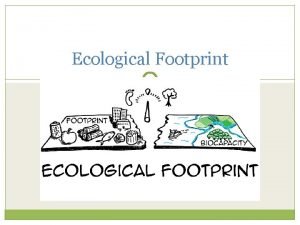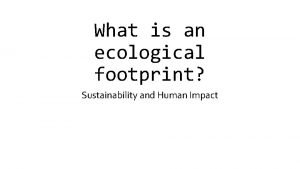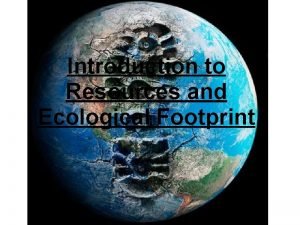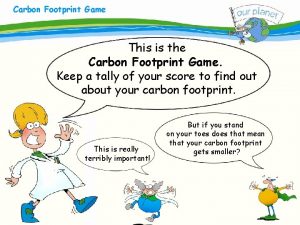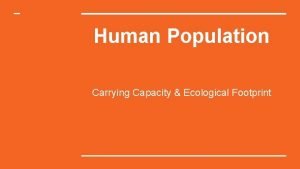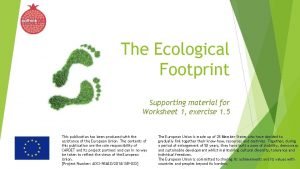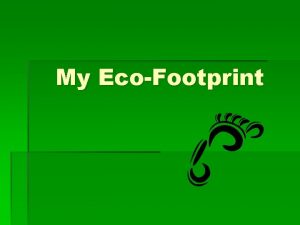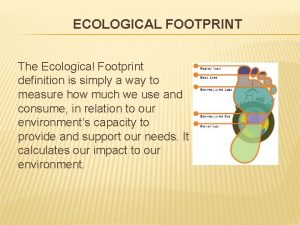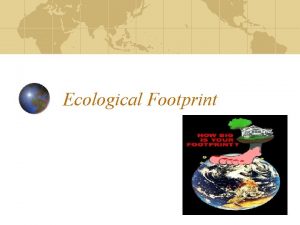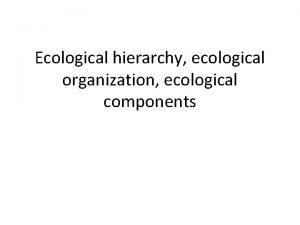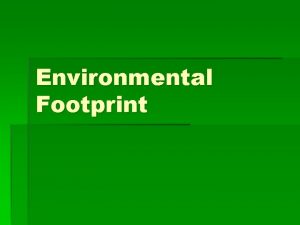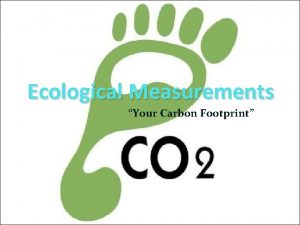ECOLOGICAL FOOTPRINT What Is the Ecological Footprint The














- Slides: 14

ECOLOGICAL FOOTPRINT

What Is the Ecological Footprint? The ecological footprint is a measure of human demand on the Earth's ecosystems. It is a standardized measure of demand for natural capital that may be contrasted with the planet's ecological capacity to regenerate. It represents the amount of biologically productive land sea area necessary to supply the resources a human population consumes, and to assimilate associated waste.

How is it measured? The total “footprint” for a designated population’s activities is measured in terms of ‘global hectares. ’ A global hectare is one hectare of biologically productive space with an annual productivity equal to the world average.

The six consumption categories: Carbon: A measure of carbon emissions, represented by the amount of forest land that would be needed to sequester carbon dioxide emissions, not including the fraction that is absorbed by the oceans and leads to acidification. Cropland: The amount of cropland used to grow plants for food, fiber, animal feed, and commodities including oil, soy and rubber. Grazing land: The amount of grazing land used to raise livestock for meat, dairy products, hide and wool. Forests: The extent of forests required to supply timber, pulp and fuel wood. Fishing grounds: The estimated primary production required to support the fish and seafood caught in freshwater and marine environments. Built-up land: The amount of land covered by human structures, including transportation, housing, industrial structures and reservoirs created by dams.

Every human produces an individual ecological footprint that is determined largely by the wealth and level of development in the country they live in—more developed countries have a larger footprint on average —but the choices we make in our daily lives also contribute.

There are only 1. 78 global hectares available person on a renewable basis. This means we are overshooting the Earth's biological capacity by nearly 50%. To sustain present levels of consumption, we would need:

If everyone in the world lived like the residents of United Arab Emirates, humanity’s annual demand on nature would equal a whopping 5 Earths per year.

We suggest how to reduce your footprint in each consumption category of carbon, food, housing, goods and services-but don't stop there – go ahead with your own responsibility.

Reduce your Carbon Footprint • Use cleaner transport • Walk, bike, or take public transit whenever possible. • Add energy-saving features to your home • Install energy saving bulbs in all your home light fixtures, . • Weatherproof your home. • Choose energy efficient appliances.

• Adopt energy-saving habits • Keep thermostat relatively low in winter and ease up on the air conditioning in summer. • Unplug your electronic when not in use. Even when turned off, items like your television, computer, and cellphone charger still sip power. • Defrost your refrigerator and freezer regularly.

Reduce your Food Footprint • Eat more local, organic, in-season foods. • Plant a garden-it doesn't get more local than that. • Shop at your local farmer's market. Look for local, in-season foods that haven't travelled long distances to reach you. • Choose foods with less packaging to reduce waste. • Eat lower on the food chain.

Reduce your Housing Footprint • Choose sustainable building materials, furnishings, and cleaning products. • Explore green design features for your building, like passive solar heating, a rainwater catchment. • Use biodegradable, non-toxic cleaning products. • Adopt water-saving habits • Take shorter showers-this not only saves water, but the energy necessary to heat it. • Run the dishwasher and the laundry machine only when full.

Reduce your Goods and Services Footprint • Buy less! Replace items only when you really need to. • Recycle all your paper, glass, aluminum, and plastic. Don't forget electronics! • Compost food waste for the garden. Garbage that is not contaminated with degradable (biological) waste can be more easily recycled and sorted, and doesn't produce methane gases (a significant greenhouse gas contributor) when stored in a landfill. • Buy recycled products, particularly those labelled "post-consumer waste. "

• Earth can ’t be ruled by economy systems • The laws of nature are stronger than those of man’s. The whole natural law system that has been managing our planet for over 4, 5 billion of years can’t wait for an agreement with men’s slow decisions and plans.
 Ecological footprint components
Ecological footprint components Whats an ecological footprint
Whats an ecological footprint Ecological footprint definition ap human geography
Ecological footprint definition ap human geography Overshoot definition apes
Overshoot definition apes Ecological footprint game
Ecological footprint game Islandwood ecological footprint
Islandwood ecological footprint The human footprint worksheet
The human footprint worksheet Ecological footprint map
Ecological footprint map Calculating ecological footprint involves consideration of
Calculating ecological footprint involves consideration of Whats a digital footprint
Whats a digital footprint Sustrex
Sustrex Understanding your digital footprint
Understanding your digital footprint How can your digital footprint affect you in the future
How can your digital footprint affect you in the future Unity footprint
Unity footprint Water footprint turkey
Water footprint turkey
